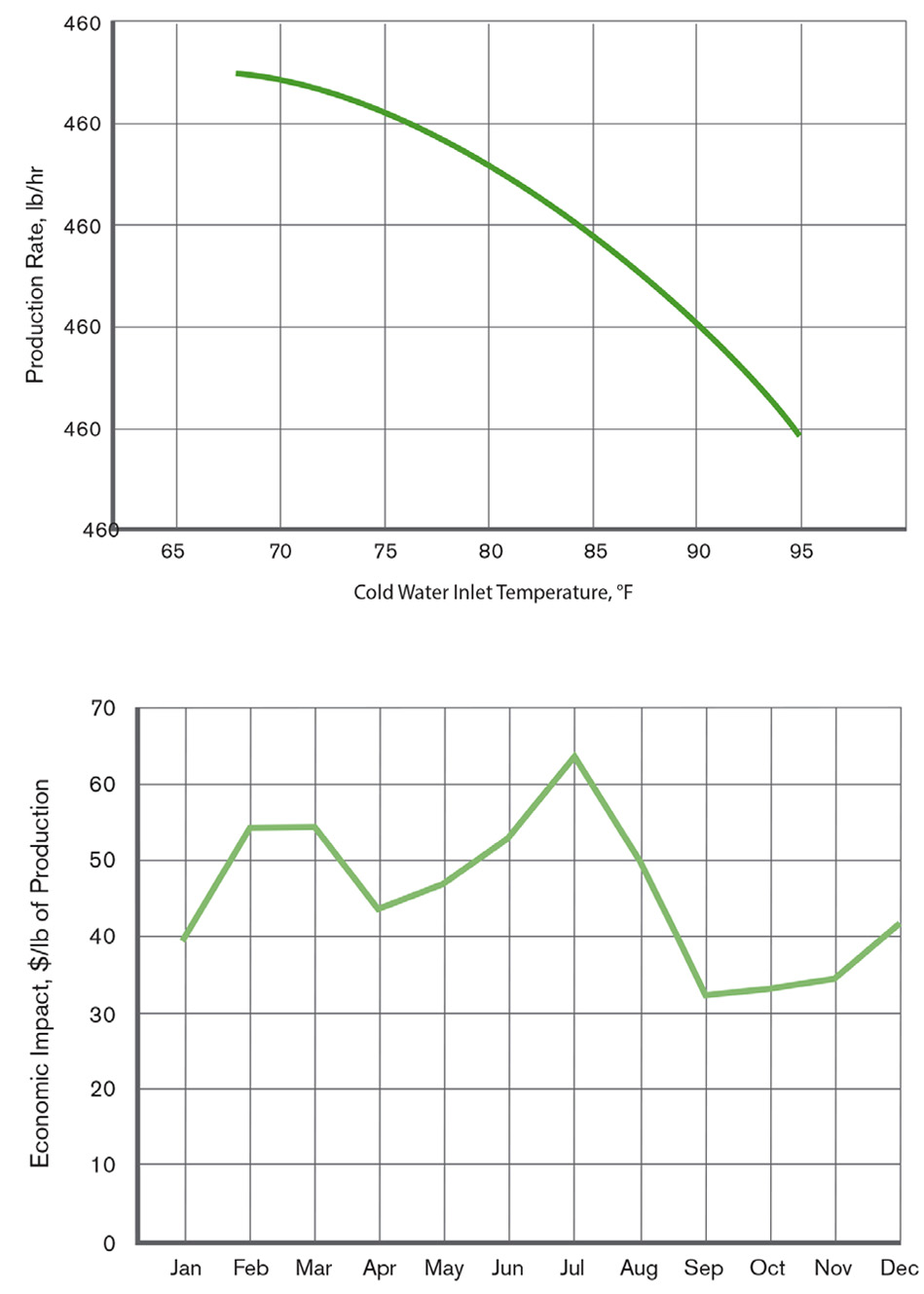在规划和评估冷却塔维修和维护计划时,很少有冷却塔业主和运营商进行彻底的经济评估。虽然简单的维修和改造可以以最低的成本完成,但更广泛的冷却塔维护项目需要适当的规划和经济论证。事实上,执行不力的经济评估可能会造成数百万美元的生产力损失。

过去,许多化学过程工业 (CPI) 工厂都采用直流冷却,从当地水源或人工水池中抽取冷却水。进水温度取决于环境因素,不可控,工厂操作员完全受环境温度条件的摆布。
多年的经验让许多操作员认为,进水温度是无能为力的。但如今的冷却技术创新通常可以在相同的水盆面积和更低的泵送扬程下提供明显更冷的水。
然而,在升级之前,应该对拟议的冷却塔维修和升级进行彻底的经济分析和论证。正确的经济分析有四个步骤:
1. 评估现有塔的热性能与设计热性能。

虽然由当地冷却塔专家进行检查和评估是确定性能缺陷可能原因的最佳方法之一,但可以使用通常可用的过程数据来评估冷却塔的性能趋势。通过在恒定风扇速度、水流量和热负荷下绘制出口冷水温度与入口湿球温度的关系来显示冷却塔的性能。是否需要进行正式的性能测试取决于几个因素。一般来说,无论冷却塔的年龄如何,安装的仪器提供的温度和流量数据越少,就越有可能需要进行正式的性能测试。
每个冷却塔的设计都旨在根据湿球温度、热负荷、水流量和空气流量的设计组合提供特定的出口温度(80-95°F)。然而,这种温度仅在设计条件下才会出现,而设计条件通常是保守选择的,因此每年出现的时间不到 200 小时。因此,在查看运行数据时,除了一年中最热的日子外,其他日子的温度都应该低于这个设计点。如果不是这样,那么冷却塔的热性能可能不够好。
即使是新塔也不太可能达到设计水平。根据冷却技术研究所 (CTI) 的数据,2014 年约有一半新建的冷却塔通过了初始性能测试。虽然 CTI 才刚刚开始根据 CTI STD-202 计划发布各个制造商的测试统计数据,但每家公司都知道自己的通过/失败率,并会根据需要披露此信息。由于新塔的失败率很高,建议在购买新设备时始终坚持进行塔性能测试。
2. 对过程对热性能变化的响应进行建模。

尽管性能评估提供了有用的技术信息,但它们缺乏经济分析。为了进行经济分析,必须对从塔中接收冷水的过程进行评估和建模。评估过程的第二步是确定较冷的水是否会对工厂性能产生可预测和可衡量的经济影响。
通常可以通过询问“夏季和冬季的工厂产能或运营成本是否存在差异?”来确定数量级的影响。如果答案是肯定的,那么一些对温度敏感的过程可能会受到冷水温度的影响。
可以对运行数据进行简单的回归分析,生成一个数学函数,用冷水温度来表示运行成本或产出。许多工厂已经完成了这种分析。工程挑战在于利用这些知识来发现提高工厂经济效益的方法。
这种分析通常很复杂,例如当多个过程依赖于一个共同的冷却回路时。在这种情况下,首先评估最关键或最敏感的过程。最好的解决方案可能是拆分冷却回路,并将最冷的水提供给工厂最有价值的部分。
对于每个与温度相关的过程,应生成一条性能与冷水温度的曲线。性能可以用产品产量、功耗或与特定过程相关的任何其他关键性能指标来表示。根据成本差异,生成一条单独的经济影响与系统性能的曲线。
3. 评估多种修复和升级方案以制定优化解决方案。

一旦建立了经济影响与系统性能之间的关系,下一步就是确定可以采取哪些措施来提高系统性能以及提高多少。
除了前两个步骤生成的曲线(现有热性能、工艺影响和经济影响)外,还需要添加年度天气变化,以开发一个比较模型,预测各种冷却塔升级项目的财务影响和回报。第一次比较通常是在“原样”性能曲线和原始设计性能曲线之间进行,以量化性能下降的财务影响。
在某些情况下,基于每个湿球温度的年总和进行简单评估可能就足够了。美国国家环境信息中心、美国国家海洋和大气管理局、 www.ncdc.noaa.gov。
如果工厂生产的产品对季节性价格波动敏感,则运行季节性性能模型更为合适。如果冷水温度影响工厂的用电量或发电量,则评估昼夜温度变化可能是合适的。目前已有气象数据软件包,可提供以三小时为单位的观测温度统计数据,从而实现这一级别的分析。
通过结合塔性能曲线、工艺性能曲线、经济影响曲线和全年气候曲线,可以预测将塔恢复到原始设计状态的经济价值。
接下来,必须确定并分析修复塔的技术方案(填充介质更换、供水系统翻新、机械部件升级),以应对整个系统更换的影响。
4.完成所提解决方案的财务优化分析。
传统上,“优化”冷却塔的选择仅仅是基于其设计点的持续运行来平衡初始成本与运营成本。然而,该模型既不考虑对工艺操作的影响,也不考虑高于或低于设计条件的操作。一个综合模型可以计算和排序多个迭代,同时考虑整个天气和操作条件,这是正确优化选择替代塔的最佳方法。
比较冷却塔安装的总体价值方程通常应包括:
- 设备和安装的资本成本
- 风扇和泵运行的电力成本
- 水处理成本
- 维护成本(对于比较购买新塔与维修/重建而言尤其重要)
- 由于工作温度较低而降低运营成本
执行此优化的第一步是确定要优化哪些财务指标。这要求推荐设备采购和升级的工程师和工厂人员了解公司对资本项目的排名和批准的评估标准,以便提出适当优化的解决方案。
评估项目的一种方法是根据简单回报设定要求。简单回报是衡量项目投资回报的非常短期的指标,计算方法是将总资本支出除以年度经济影响。简单回报是一种主要用于受限环境的筛选工具,很少用作对资本支出进行排名和评估的主要指标。更常见的指标,如内部收益率 (IRR)、现金流净现值 (NPV) 和经济增加值 (EVA),为长期价值提供了更有意义的信息。
然而,经验表明,仅优化一项措施可能不是最佳选择。因此,在进行系统优化时,考虑适当的财务指标至关重要。最终,“最佳”解决方案将主要取决于所需的财务结果——快速回报或最大长期价值。
由于冷水温度和工艺性能之间密切相关,因此,在彻底了解冷却塔设计、工艺操作和财务指标的基础上,规划和评估冷却塔的升级和维修至关重要。
从本质上讲,工程是一项以科学为基础的经济活动;虽然冷却塔运行的科学原理非常简单,但经济分析需要严格的纪律,以保证资本和维护费用产生预期的回报。许多冷却塔改进项目具有显著的经济效益,这些效益可以通过适当的经济分析来揭示——而推迟某些维修和升级可能会使工厂损失数百万美元的生产力和过高的运营成本。

